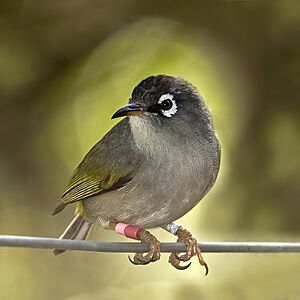Mauritius olive white-eye facts for kids
Quick facts for kids Mauritius olive |
|
|---|---|
 |
|
| On Île aux Aigrettes | |
| Conservation status | |
| Scientific classification | |
| Genus: |
Zosterops
|
| Species: |
chloronothos
|
 |
|
| Range highlighted in red | |
| Synonyms | |
|
Zosterops chloronothus |
|
The Mauritius olive white-eye (Zosterops chloronothos) is a very rare and special bird. It belongs to a group of birds called white-eyes. This bird is found only on the island of Mauritius. It is one of two white-eye species that live only there. The other is the Mauritius grey white-eye.
Contents
What Does the Mauritius Olive White-eye Look Like?
This small bird is about 10 cm long. Its top feathers are a dull olive-green color. Its belly and underside are lighter, with a yellow tint. A bright white ring around its eyes makes it easy to spot. Both male and female birds look very similar.
The Mauritius olive white-eye lives in evergreen forests and bushes. You can find it in places like the Black River Gorges National Park and the Macchabée-Bel Ombre Biosphere Reserve. It has also been brought back to Île aux Aigrettes. These birds love to eat nectar from flowers and small insects.
Life Cycle and Reproduction
The breeding season for these birds is from September to March. During this time, they build a cup-shaped nest. They hide it well among the leaves. The female bird lays two pale eggs. Both the male and female take turns sitting on the eggs.
Usually, only one baby bird grows up. It leaves the nest after about 14 days.
Why is This Bird Endangered?
The Mauritius olive white-eye is one of the rarest birds on Mauritius. It lives in a small area, only about 25 square kilometers. Its biggest problems are animals that were brought to the island. These include rats and crab-eating macaques. These animals often destroy the birds' nests.
The number of these birds has dropped a lot. In 1975, there were about 350 pairs. By 2002, there were only 120 pairs left. Another problem is that these birds need nectar from special local flowers. When new plant species were brought to Mauritius, these native flowers became less common. This means less food for the birds. The Mauritian Wildlife Foundation (MWF) now watches over every nest they find.
Helping the Mauritius Olive White-eye
Many groups are working to protect this bird. The MWF has done a lot to help. From 2005 to 2009, they collected nests from around Mauritius. They did this for two main reasons. First, it stopped the eggs from being eaten by predators. Second, it allowed them to raise the chicks safely. Then, they could release the birds on islands without predators.
When a chick hatches, it gets a special diet. It eats small amounts of food every forty minutes. After that, the young birds go into small cages. Here, they learn to drink and eat on their own. They also learn how to fly. Once the birds are ready, they are set free on Île aux Aigrettes. This island has no predators, and the birds have started to have their own babies there.
Gallery






